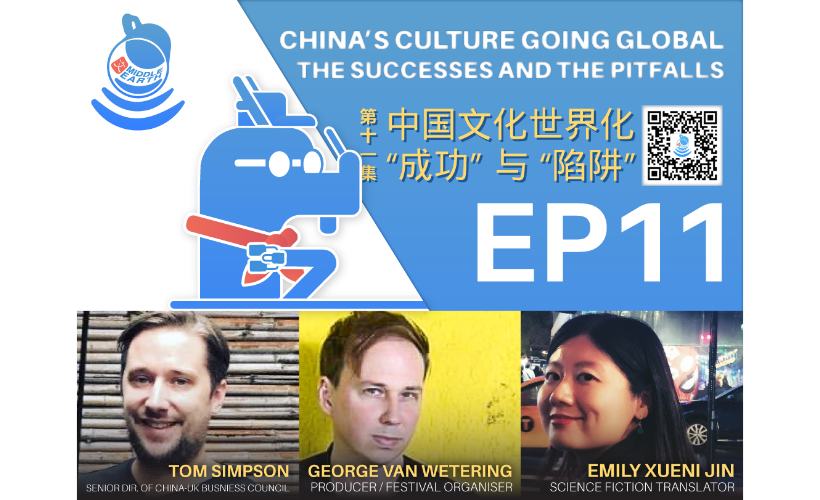China has found success in exporting domestic technology and consumer goods. However, its culture exportation has not achieved the same success. The language barrier may be an issue, yet South Korean and Japanese films and music have managed to overcome it and found success in exporting cultural products like video games, anime, and movies. So what gives? On this episode of the Middle Earth Podcast, the guests discuss the recent successes and failures of China’s culture going abroad.
This episode was recorded during a panel at the WISE Festival 2019 at the Ullens Center for Contemporary Art in Beijing.
Featuring:
Emily Xueni Jin – science fiction translator
Tom Simpson – senior director of the China-Britain Business Council
George van Wetering – composer and event organizer
And Sha Hua (华沙), host of the talk, and a journalist for the Handelsblatt
Three main takeaways from this week’s episode:
从这期访谈中,我们总结出三个主要观点:
1) Yes, the language barrier is an issue, but it is not the only one.
If a Chinese indie band or film producer wants to have their work paid attention to by Western audiences, they have to upload the art onto Western social media platforms (YouTube, Vimeo, Soundcloud, etc). Circumnavigating the Great Firewall of China makes this difficult, as well as the need to interact with fans in English. At the same time, non-Chinese individuals aren’t willing (or don’t know how) to surf the Chinese internet. But there is evidence that the language barrier can be successfully traversed: The first video to hit a billion views on YouTube was “Gangnam Style” by the South Korean singer PSY. Yet, in defense of China’s producers, the domestic market is such a huge market compared with South Korea’s that Chinese artists and producers don’t necessarily need to go global in order to survive.
2) There is still Orientalism and a lack of general knowledge about China in the West.
As science-fiction writer Emily Xueni Jin pointed out, when you need to translate a Chinese concept or a mythical beast into English, should you borrow its Western equivalent or write it in pinyin and describe it? There is often a tough choice to make: to balance a “Chinese style” to highlight your stylistic differences, or to use an approach that could be construed as Westernization or Orientalism to garner a larger audience.
3) China manages to export three types of cultural products.
When you look at the cultural products China sells abroad, only three types really stand out. The first is classical paintings and calligraphy. Given the lack of interest in these things among China’s own domestic youth, it prompts the question of how successful they could be abroad. The second is science-fiction works, which, surprisingly, work really well abroad. Perhaps this is because questions about the future of our planet, and how we should embrace technology, are universally understood. The last (and least known) is foreign films. A few years ago, some companies decided to invest in them. The Academy Award–winning film for Best Picture, Green Book, had a backing by Alibaba Pictures. Maybe after investing and learning for several years, Chinese companies will know how to make a global blockbuster film.
One could make the argument that films from the 1990s are examples of China’s globalizing culture industry. However, films that toe the line of acceptability are being produced in far lower volume, and face greater levels of censorship.
Recommended watching and listening:
The science-fiction short story “The Facecrafter,” by Anna Wu.
The science-fiction book The Waste Tide, by Chen Qiufan.
The pop singer Faye Wong 王菲.
The artists Fang Lijun, Yue Minjun, and Wang Guangyi.
The film producer David Haymen.
The “Four Generations Challenge” meme.







